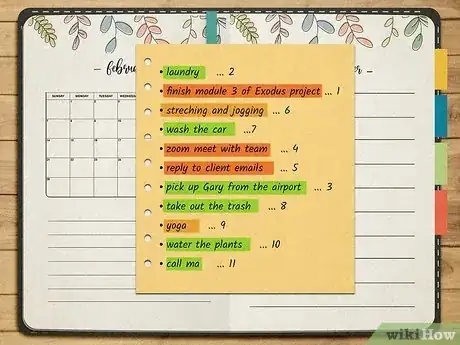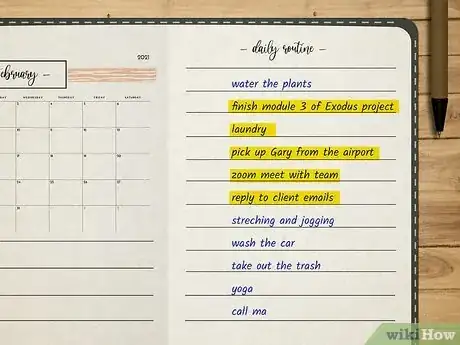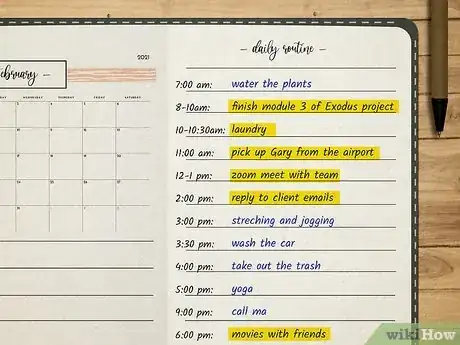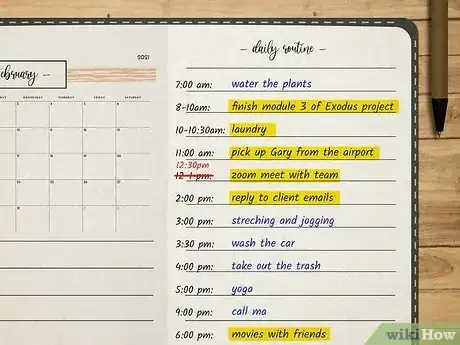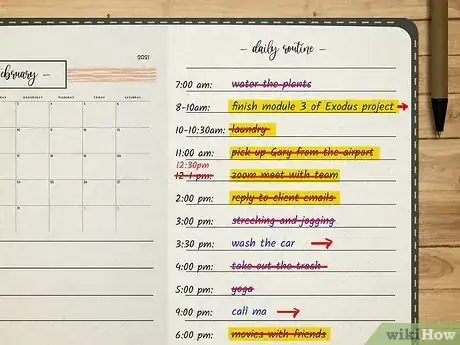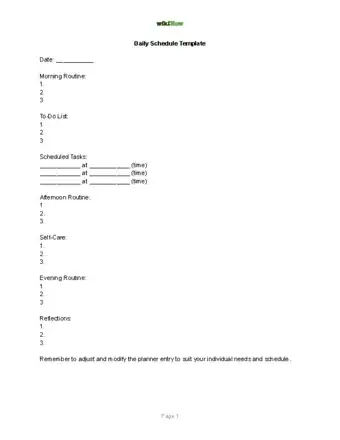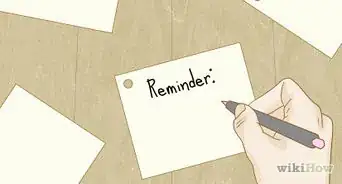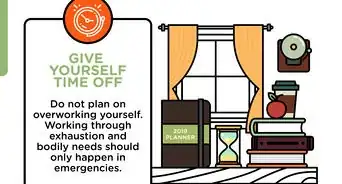This article was co-authored by Kathi Burns, CPO®. Kathi Burns is a board certified Professional Organizer (CPO) and Founder of Organized and Energized!, her consulting business with a mission to empower people to master their environment and personal image by assisting them in taking control, making change and organizing their lives. Kathi has over 17 years of organizing experience and her work has been featured on Better Homes and Gardens, NBC News, Good Morning America, and Entrepreneur. She has a BS in Communication from Ohio University.
wikiHow marks an article as reader-approved once it receives enough positive feedback. This article received 15 testimonials and 100% of readers who voted found it helpful, earning it our reader-approved status.
This article has been viewed 806,256 times.
Keeping a schedule for your day will help you manage your time more efficiently. You can get more done and are less likely to forget tasks or become sidetracked. Although it may seem simpler to take things on as they come, you may find yourself overwhelmed, disorganized, and forgetting things. Making and keeping a schedule can take a little getting used to, but soon you'll be glad you did--it will help you decrease your stress and make you feel more in control of your life. Scheduling your day allows you to self-regulate and track your own behavior by keeping records of what you need to do and have done.
Steps
Making a Schedule
-
1Obtain a calendar or planner. Make sure the calendar has appropriate space for you to list your tasks. Some calendars offer weekly, daily, or hourly planners. A notebook can also be used. Choose whatever best suits your wants and needs.[1] Whatever you choose, commit to your choice. Do not try to have one planner for work, one for school, etc. Everything should be in one place.[2]
- There are also many digital calendars for your phone or laptop that can synch to all of your electronic devices so that you always have ready access to your calendar wherever you are. There are also a number of apps that can help you schedule your day with reminders and timers.[3]
- You might want to choose a digital or paper calendar that has some extra space so you can add notes to your schedule. This can help you keep track of not only what you've done but how you did it and/or how it made you feel. For example, maybe below the section "Go to the gym" on your calendar, you want to not only check it off but also note that you "Ran an extra mile today and felt great!" Adding notes can help you keep better track of your behavior.[4]
- If you are making the switch from a paper to digital calendar, you may find things a bit hectic for a day or two as you get used to the new system. Keep both with you for the first few days and check to make sure nothing has been left out or double-booked.
-
2Organize your tasks. Electronic calendars allow you to color coordinate different tasks. For example, you can color work-related things red, school-related things blue, housework green, vacations orange, and exercise pink. You can also do this easily if you're using a paper calendar or notebook; simply use colored pens or pencils or highlighters. Once you've differentiated the different types of tasks you need to schedule, you can work to prioritize them.
- Organizing and color-coding your tasks will also help you visualize and understand where a lot of your time is going. You might see, for example, that there is a ton of red (work) and green (housework) on your schedule, but very little pink (exercise). Noticing the dearth of exercise might help you get motivated to try to schedule more time for it.
Advertisement -
3Prioritize your tasks. It's important you determine which tasks are most important and should be done first and which can wait. Let's use an example to understand prioritization. Let's say you have two tests, a lab report, an essay, and presentation all in the same week. Yikes!
- Ask yourself some questions in order to figure out what should be done first and for how long: Which task is due first? Which tasks will take the longest time to complete? Which tasks are most important, relative to their value? For example, how much are the tests, lab report, essay, and presentation worth in terms of your final grade? Which task will be the most challenging?
- Ultimately, you will need to decide whether the deadline, length of time needed or relative value of your scheduled tasks is your priority. You know yourself and your abilities best. Choose a priority system that fits you.[5]
-
4Mark your prioritized tasks. Once you've decided how to prioritize your tasks, mark them down on your schedule. You can go through your daily schedule and write "A" next to important items that must be done first, "B" next to items that must be done before tomorrow, "C" next to items that must be done by Friday, and so on.
-
5Schedule a time for each task. Write how long you expect to spend on each task. For example, you may have scheduled time in a given day to study (2 hours), workout (1 hour), write two emails (30 minutes), and walk the dog (30 minutes). It's key to allow you the necessary amount of time to complete each task; you'll only stress yourself out if you schedule yourself too tightly and aren't realistic about the amount of time things take.
- Remember to incorporate travel time into your scheduling. For example, do you need to drive from the library where you are studying to the gym?
-
6Add time cushions to your schedule. Most people generally underestimate the amount of time tasks take. Considering all of the time that goes into even preparing to do certain tasks and winding down from them afterwards will help you schedule your day with better accuracy.
- Always try to overestimate how long something will take by a few minutes. Try adding 25% to the time you allot for tasks in your schedule. For instance, schedule something that technically takes 4 minutes for 5 minutes, and tasks that technically take 8 minutes for 10 minutes, and so on. These extra minutes will add up and provide a cushion which can help you avoid being late or falling behind.
- Ask yourself whether there are any additional small tasks surrounding the bigger tasks that need to be factored into your schedule? For example, do you need to shower after the gym? Do you usually end up chatting with a friend for 15 minutes in the change room? Most people find that their scheduled one-hour workout is actually more like two hours.
-
7Leave space in your schedule. Keep some free space at the bottom of your schedule for low priority items or things coming up later in the week. If you have time today or at any other point during your week, you can begin working on those items to get ahead. These additional tasks might include going through your closet or organizing your tax filing system at home. These are low priority tasks that you'd eventually like to get done but are not pressing or tied to a specific deadline.
Keeping to the Schedule
-
1Check your calendar/planner. Make it a habit to check your calendar every morning and night to prepare for the day ahead. Each day you should also schedule a few minutes, maybe after you get your morning coffee, or during your daily commute, to review what needs to be done for the day and to add new things or check old things off.
- Surveying and working on your schedule for a few minutes before digging into it can be a great way to start your day motivated!
- Use the alarm on your phone or computer to remind you of certain tasks or appointments. [6] Many doctor and dentist appointments are booked far in advance, for example. It can be helpful to set a reminder that will go off a week or so before the appointment. That way, you can plan accordingly.
-
2Complete your tasks in order of priority. You've already designated your list of priorities in your schedule, so work through them steadily.
-
3Adjust your schedule as needed. Although you should try to stick to your schedule as much as possible, sometimes things happen and you need to make adjustments. Move flexible items or those that are less of a priority to another day should a scheduling emergency, complication or conflict arise.
- However, be careful not to let your tasks pile up and spill over too frequently into the next day. If you find this happening a lot, try giving yourself more time for each task on the day scheduled, rather than having to rearrange the next few days.
-
4Check off tasks that are completed. This can be very rewarding for a lot of people! Remember to transfer items not done today to tomorrow's schedule.
-
5Reward yourself! It's important to give yourself some positive reinforcement after you've completed your tasks and kept to your schedule. After you've completed your duties for the day, reward yourself with a soothing soak in the tub, your favorite TV show, or a sweet snack. You'll feel accomplished and deserving of those rewards when you've earned them.[7]
-
6Assess and make adjustments as needed. It's important to check in every once in a while and figure out whether your schedule is working for you. One way to do this is to look at your day planner while also evaluating your own mood and feelings. Are you seeing mostly check marks next to tasks and generally feeling positive and productive? If you answer "yes", then your schedule is likely working well for you!
- However, if you're finding that too many tasks often get pushed to the next day (and then the day after that, and so on) and that you feel demoralized, you should probably make some adjustments to your schedule.
- Identify problem areas by looking at your planner and seeing what is falling behind. You may need to reevaluate and re-order your priorities if the thing that is falling by the wayside is important to you (such as exercise). You also might need to reconsider the time allotted for each task.[8] For example, instead of giving yourself 2 hours in the morning to get ready, consider reducing that time to 1 hour three days a week and schedule in a 30-minute jog with the extra time freed up.
- Be aware that re-jigging your schedule is common and totally normal. It takes time for people to develop a routine that works best for them.
-
7Pre-plan for the next day. Rather than waiting until the morning, start preparing yourself the night before so you have more time. Pick an outfit and set it out so you don't have to search for clothes, set the things you'll need on a table or counter, and hang your keys near your door. That way, you can easily get ready for the day without wasting any time.[9]
- Try setting your clock a few minutes ahead of the actual time so you have a buffer.[10]
Daily Schedule Template
Expert Q&A
Did you know you can get expert answers for this article?
Unlock expert answers by supporting wikiHow
-
QuestionHow do I schedule my day and week?
 Kathi Burns, CPO®Kathi Burns is a board certified Professional Organizer (CPO) and Founder of Organized and Energized!, her consulting business with a mission to empower people to master their environment and personal image by assisting them in taking control, making change and organizing their lives. Kathi has over 17 years of organizing experience and her work has been featured on Better Homes and Gardens, NBC News, Good Morning America, and Entrepreneur. She has a BS in Communication from Ohio University.
Kathi Burns, CPO®Kathi Burns is a board certified Professional Organizer (CPO) and Founder of Organized and Energized!, her consulting business with a mission to empower people to master their environment and personal image by assisting them in taking control, making change and organizing their lives. Kathi has over 17 years of organizing experience and her work has been featured on Better Homes and Gardens, NBC News, Good Morning America, and Entrepreneur. She has a BS in Communication from Ohio University.
Board Certified Professional Organizer
Warnings
- Avoid procrastination. It only leaves you extremely stressed, unorganized, and just plain irritable.⧼thumbs_response⧽
References
- ↑ http://www.entrepreneur.com/article/234145
- ↑ http://www.entrepreneur.com/article/234145
- ↑ http://www.collegefashion.net/college-life/how-to-keep-a-schedule/
- ↑ https://www.fool.com/the-ascent/small-business/appointment-scheduling/articles/google-calendar-scheduling-tool/
- ↑ http://www.mindtools.com/pages/article/newHTE_05.htm
- ↑ https://www.fool.com/the-ascent/small-business/appointment-scheduling/articles/google-calendar-scheduling-tool/
- ↑ https://www.bowdoin.edu/baldwin-center/pdf/handout-self-rewards.pdf
- ↑ Kathi Burns, CPO®. Board Certified Professional Organizer. Expert Interview. 31 December 2019.
- ↑ Kathi Burns, CPO®. Board Certified Professional Organizer. Expert Interview. 31 December 2019.
- ↑ Kathi Burns, CPO®. Board Certified Professional Organizer. Expert Interview. 31 December 2019.
About This Article
To schedule your day, start by writing down all of the tasks you want to accomplish, putting the most important tasks that absolutely need to get done at the top of your list. Then, write in how long you think it will take to do each task so you know what you can realistically fit into your schedule. Try to overestimate how long you think something will take since things tend to take longer than we expect. Also, leave some free time in your schedule in case something comes up or you want to work on something else. To learn how to stick to your daily schedule, scroll down!


